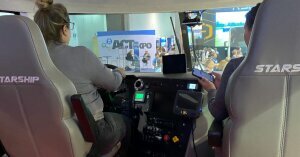Shell, the global energy company, has been making efforts towards decarbonization since 2018 through its Shell Starship initiative. In its latest endeavor, the company has introduced the new Starship 3.0, revealed at ACT Expo in Anaheim, California. The Starship 3.0, powered by renewable natural gas (RNG), features the latest technologies available for heavy transport vehicles.
According to Dr. Selda Gunsel, president of Shell Global Solutions and vice president of Fuels and Lubricants Technology at Shell, "Shell Starship 3.0 will feature some of the best-in-class technologies which are leading the way forward in helping decarbonize the heavy transport sector."
The use of RNG in the Cummins X15N natural gas engine gives it a low carbon intensity rating, providing the new Starship with an excellent alternative fuel choice.
 (Credit: Marisa Higgins)
(Credit: Marisa Higgins)Shell RNG’s fleet fuel is combined with low-friction Shell Rotella lubricants. This makes the natural gas engine an ideal choice for the next evolution of Starship. Even more, the new truck has features that promote lightweight, low aerodynamic drag, and low rolling resistance tires from Bridgestone. The interior of the truck has also been updated and offers a spacious seating area with a built-in plush sofa.
Of course, the heavy transport sector is responsible for a significant amount of greenhouse gas emissions, which makes it a crucial area for decarbonization efforts. According to the California Air Resources Board, the use of RNG as a fuel for heavy-duty vehicles can reduce emissions by up to 70% compared to diesel.
The Shell Starship demonstrates the company's commitment to decarbonization. The need for companies to take responsibility for their impact on the environment is vital. Shell’s efforts to reduce its carbon footprint with Starship 3.0 sets an example for the heavy transport sector.
Their action shows that it is possible to adopt sustainable practices while maintaining efficiency and productivity. The Shell Starship will make a demonstration run from San Diego to Jacksonville, Florida, in August. This route was used in previous cross-country runs. The North American Council for Freight Efficiency (NACFE) will monitor the results.